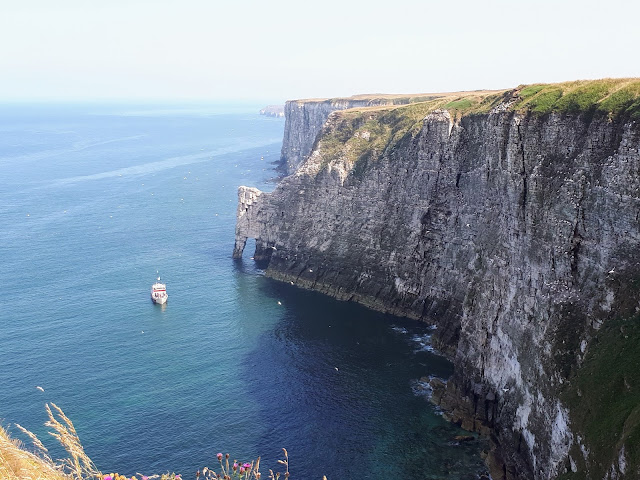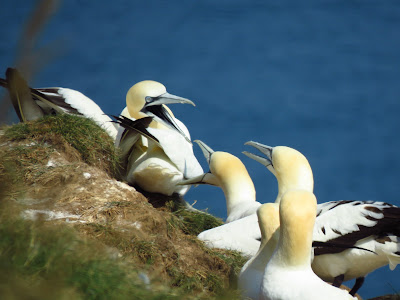The Black-browed Albatross has been in residence at Bempton for three weeks now. This species, also known as the Black-browed Mollymawk, is usually found in the southern seas, a pelagic bird outside the breeding season, it breeds on islands in the South Atlantic and off New Zealand. The Black-browed Albatross is an abundant and widespread species, the only species not regarded as threatened. This individual accidentally strayed from the usual range some years ago, and appears to have remained in the North Sea since. It was first spotted in
May 2014 in Heligoland, Germany, feeding in the company of Gannets. It first appeared in
Bempton in 2017, and then visited again in 2020. It was
feared dead earlier this year, after it was atacked by White-tailed eagles between Denmark and Sweden, so it was a pleasant surprise when it turned up at Bempton on the 28th of June. Although it hasn't been seen every day since, it seems to have a developed pattern in which it roosts at Staple Newk, at the Gannet colony. It may leave quite early in the morning and not come back until the afternoon and often disappears during the rest of the day, although it is quite variable and it could turn up any time. I didn't even consider to go and see it the first couple of weeks when it was back, as I expected the cliffs to be very busy. In the last couple of days, the lure of the albatross proved too strong, and I made my mind that I would go to see it. I thought my best chance was to try and get there quite early in the morning and if I didn't see it, then stay to wait for it to return in the afternoon. A whole day at Bempton, even without an albatross, is never a bad proposition.

The crowd gathered at 6:30 am at new Roll Up.
The view towards Staple Newk.
The forecast was for another warm clear day, but as I was driving there there was fog patches and was quite cool. I got to the reserve at 6:30 and went straight towards Staple Newk viewing point. It was misty over the calm sea, although it looked like it was going to clear soon as a light breeze was blowing.
The Black-browed Albatross
Birders are congregated on the New Roll-up viewing point and watching the albatross, who was on the water, offshore, slowly drifting west. I quickly have my first glimpse of the bird through a kind man's telescope. I manage to find the albatross on the water after some searching with my binoculars. Its black back and elongated body and big bill made it quite distinctive. After waiting for the mist to lift a bit I managed my first record shot of this species, my first lifer this year!

The Albatross on the sea.
With a passing Gannet.
Dolphins
As we tried to relocate the albatross, a pod of Bottlenose Dolphins stole the show, nine are visible surfacing in a short clip I took. They were swimming in very tight formation, coming out to breath one after the other like clockwork. The pod of Bottlenose dolphins that visits Flamborough comes from the Firth of Forth, some individuals have been identified by their distinctive features.
After this, the albatross became harder to spot as it drifted along towards Buckton. I decided to move to the next viewing point, to try and get closer views. Finding the albatross on the water was an exciting challenge, as it was still quite distant and the reference points almost non-existent. It really was exhilarating to spot it again. I moved to Bartlett Nab and I found it and then lost it again, at which point it was even further away. It was time for a break and a walk to enjoy the wonders of the reserve at this time of year.
Bempton in July
I met a young birder who had just started a year ago, and had never been to Bempton. He got a bunch of lifers, including Gannets, Puffins, Guillemots and Razorbills, and of course the Black-browed Albatross. He mentioned that he hadn't seen Fulmar yet, and I pointed at a couple on the cliffs, which are visible from New Roll up. What a day to come to Bempton, he'll probably remember for ever! I've been to Bempton many times and still it is still a amazing experience. Never mind if I had missed the albatross, it was still going to be a super day. So, what were the usual residents of the cliffs doing?
Guillemots and Razorbills were scarce on the cliffs, their chicks (jumplings) have already left the nests, jumping from the hights onto the sea, beating their tiny wings for balance, and closely followed by their fathers. Those still on the nests are likely to be females.
A Razorbill has a rest on the cliffs.
I didn't see any fulmar chicks. A few fulmars circled the cliffs and two were visible on their nest sites.

Puffins were also showing scattered along the cliffs.
There were plenty of Kittiwakes about, their young quite grown up, showing the distinctive juvenile pattern. Some were panting on the more exposed nests.

And of course there were gannets, plenty of them. If you scanned the cliffs carefully many were sitting next to their 'gugas' the name for their chicks.
A young Gannet begs to be fed to its parent.
Gannets on nests with chicks.
The guga in the centre, at Staple Newk, is older than those around, with its feathers well grown and getting to its parents size.
An immature Gannet atop the cliff.
Portrait of immature Gannet.
Groups of immature Gannets were gathered displaying, bonding and threatening their neighbours.
A gannet preens its partner.
Bill open, it's black mouths visible.
If you looked offshore, there were areas where Gannets were feeding in their hundreds, diving from high in squadrons. It was a spectacular sight!
The sea was boiling with the splashes of diving gannets.
Although not the most popular, Herring Gulls breed at Bempton.
This herring gull had two grown chicks
After being harassed by both chicks the Herring Gull started long-calling.
Rock/Feral Pigeons and Jackdaws also breed on the cliffs. I didn't see other cliff residents: Peregrine and Shag. The Jackdaws are very tame and walk around the visitor centre taking care on any bits of dropped food. The youngsters are around now, very inquisitive, some still begging from their parents. This young Jackdaw landed right next to me at new Roll Up. I took this photo with my phone.
Great Black-backed gulls don't breed at Bempton, although they can be found year round. I watched as a juvenile Great Black-backed gull swallowed a floating dead bird, possibly a kittiwake. Afterwards, an adult was also feeding on another dead bird. Although capable of hunting, they are efficient scavengers and will take care of any casualties fallen to the bottom of the cliffs.
Great Black-backed gull with meal.
Bempton has other habitats than cliffs: grassland and hedges, and a small wild sheltered hollow just at the entrance of the reserve, with trees: The Dell. I walked around it and spotted an unusual bird: a young Marsh Tit hunting on a willow.


Marsh Tit.
The grassland was alive with Tree Sparrows, Linnets, Skylarks and Reed Buntings singing and Meadow Pipits displaying. If you are lucky you may hear or see Corn Buntings.
Linnet.
Amazingly, this blackbird with a beak full of worms, was able to sing!
A pair of Swallows has settled in the artificial nests in the visitor centre. The bill of one of the chicks is visible just above the rim.
I visited the pond. It was mostly covered by a carpet of Potamogeton, which was strong enough to hold the weight of birds that streamed in to bathe or drink. A Linnet here.
Linnet having a bath.
Some young Tree Sparrows come down to the pond.
After lunch and some quiet time by the visitor centre, I headed back to the cliffs. There had been reports that the albatross had been seen at Thornwick bay. Around 3 pm I moved to New Roll Up to wait for the Albatross to return. In the meantime, I took some photos of Staple Newk with the Yorkshire Belle approaching (top shot).
The view from New Roll up.
At 3:30, someone called, 'it's here!' and everyone knew who! More than a dozen binoculars and cameras zoomed in towards Staple Newk. A couple volunteered as live commentators, helping people focus on the circling albatross with their detailed description of the location of the albatross. It went round and round Staple Newk, sometimes higher than others. It is thanks to them I could be prepared and taken this in flight photos.
Showing its magnificent wingspan of over 2 m.
We enjoyed over twenty wonderful minutes of constant aerial display around the jutting cliff, wings, stretched, barely any flapping, gliding effortlessly over the gannet colony. All the time, the Yorkshire Belle had stopped at the bottom of Staple Newk, and we wondered of her passengers having the albatross flying over their heads. The albatross was intent on roosting, and made several failed landing attempts (accompanied of many 'ooohhh!' by the watching public). One of the last ones dislodged several gannets from their positions. With the crowd gasping, the albatross finally landed amongst the gannets. it stretched and folded its wings, and sat down. The gannets nearby pointed at it with their bills as the albatross appeared to do some greeting movements, bowing its head, tail spread.
Albatross, finally sat down.
It was time for me to leave the albatross. I'm very glad I decided to stay, what wonderful 10 hours at Bempton!







































2 comments:
Phew! Well I made it, all the way to the bottom of the page! What an incredible blog!!! Your knowledge, Africa, is stunning and I love the prose.
Brilliant to meet you at Bempton, you are one of the inspiring people it is always a thrill to meet and talk with.
All the very best, Gary - The Biking Birder
Hi Gary, sorry it took me so long to read your reply, somehow missed it. It was a pleasure to meet you too and hear about your plans, especially in such a memorable day. This must have been one of the longest blog post I've written, but again, lots of things happen in 10 hours at Bempton!
Post a Comment